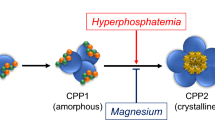Abstract
Background
Inflammation has been associated with atherosclerotic cardiovascular disease (CVD) and anemia in patients with end-stage renal disease (ESRD) which may lead to left ventricular impairment via myocardial hypertrophy and/or ischemia. We therefore sought to investigate serum levels of sFas in uremic patients and its correlation with known markers of inflammation and CVD.
Methods
The study included 30 patients on hemodialysis, 30 patients with chronic kidney disease (CKD), and 30 normal control subjects. We measured serum levels of sFas, C-reactive protein (CRP), and albumin. We also investigated the association of serum sFas levels with the presence of CVD by echocardiographic assessment before and after 1 year.
Results
Levels of sFas were elevated in CKD and ESRD patients compared to controls. sFas levels correlated positively with serum creatinine and negatively with serum albumin. In the dialysis patients, we observed that sFas levels were higher among those with CVD. Compared with baseline, after 1 year of follow-up there was a significant decrease in left ventricular (LV) ejection fraction, increases in LV end-diastolic dimension and LV end-systolic dimension, and myocardial ischemic changes.
Conclusions
These results suggest that sFas may be a marker of inflammation in CKD and ESRD patients.
Similar content being viewed by others
References
Locatelli F, Marcelli D, Conte F, Leunissen K, Luno J, Chazot C. Cardiovascular disease in chronic renal failure: the challenge continues. Nephrol Dial Transplant. 2001;15(Suppl 5):S69–80.
Petrosa G, Simone S, Soccio M, Marrone D, Gradaliano G. Chronic inflammation cardiovascular disease in hemodialysis. G Ital Nefrol. 2003;20(6):631–40.
Ridker PM, Hennekens CH, Burning JE, et al. C-reactive protein and other markers of inflammation in the prediction of cardiovascular disease in women. N Eng J Med. 2000;342:836–43.
Park CW, Shin YS, Kim CM, et al. Increased C-reactive protein following hemodialysis predicts cardiac hypertrophy in chronic hemodialysis patients. Am J Kidney Dis. 2002;40(6):1340–1.
Kalantar-Zadeh K, Kopple JD. Relative contributions of nutrition and inflammation to clinical outcome in dialysis patients. Am J Kidney Dis. 2001;38:1343–50.
Cleveland JL, Ihle JN. The Fas and the cytoplasmic apoptosis. Cell. 1995;81:479–83.
Dalboni M, Sardenberg C, Andreoli M, et al. Soluble Fas. A novel marker of inflammation in uremia. Artif Organs. 2003;27(8):687–91.
Sahn DJ, DeMaria A, Kisslo J, Weyman A. Recommendations regarding quantitation in M-mode echocardiography: results of a survey of echocardiographic measurements. Circulation. 1978;58:1072–83.
Nagata S, Goldstein P. The Fas death factor. Science. 1995;25:1449–56.
Perianayagam MC, Murray SL, Balakrishnan VS, et al. Serum soluble Fas (CD95) and Fas legend profiles in chronic kidney failure. J Lab Clin Med. 2000;136:320–7.
Santoro A, Mancini E. Cardiac effects of chronic inflammation in dialysis patients. Nephrol Dial Transplant. 2002;17(8):10–5.
Serneri GGN, Prisco D, Martini F, et al. Acute T-cell activation is detectable in unstable angina. Circulation. 1997;95:1806–12.
Okuyama M, Yamaguchi S, Nozaki N, Yamaoka M, Shirakabe M, Tomoike H. Serum levels of soluble form of Fas molecule in patients with congestive heart failure. Am J Cardiol. 1997;79:01–1698.
Nishigaki K, Minatoguchi S, Seishima M, et al. Plasma Fas legend, an inducer of apoptosis, and plasma soluble Fas, an inhibitor of apoptosis, in patients with chronic heart failure. J Am Coll Cardiol. 1997;29:1214–20.
Watanabe-Fukunaga R, Brannan CI, Itoh N, Yonehara S, et al. The cDNA structure, expression, and chromosomal assignment of the mouse Fas antigen. J Immunol. 1992;148:1274–9.
Matsumori A, Yamada T, Suzuki H, Matoba Y, Sasayama S. Increased circulating cytokines in patients with myocarditis and cardiomyopathy. Br Heart J. 1994;72:561–6.
Cheng J, Zhou T, Liu C, Shapiro JP, et al. Protection from Fas-mediated apoptosis by a soluble form of the Fas molecule. Science. 1994;263:1759–62.
Acknowledgments
The authors acknowledge the staff members of the cardiac unit at Mansoura University, who helped to study and report the echocardiographic data.
Author information
Authors and Affiliations
Corresponding author
About this article
Cite this article
El-Agroudy, A.E., El-Baz, A. Soluble Fas: a useful marker of inflammation and cardiovascular diseases in uremic patients. Clin Exp Nephrol 14, 152–157 (2010). https://doi.org/10.1007/s10157-009-0261-8
Received:
Accepted:
Published:
Issue Date:
DOI: https://doi.org/10.1007/s10157-009-0261-8




